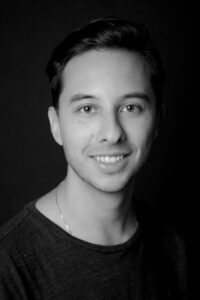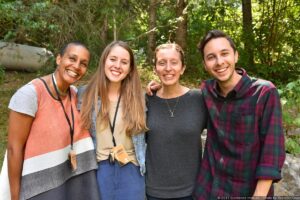New York Film Academy (NYFA) Filmmaking Alum Enrique Pedráza Botero doesn’t just write and direct films—he also helps other filmmakers bring their documentaries to life through his work at the Sundance Institute’s Documentary Film Program (DFP). While Sundance is synonymous with its prestigious film festival, its documentary film program and creative labs are working year round to bring new and unique voices to the world of nonfiction cinema.
Botero is originally from Colombia and first enrolled at New York Film Academy’s New York campus in 2010, before finishing his studies at NYFA-Los Angeles where he earned his BFA in Filmmaking. “I miss my time at NYFA,” Botero tells the Academy. “I loved the school and their open-minded philosophy about the approach to the work … I connect to the importance of discovering your interests and voice as a filmmaker by actually shooting and seeing through the camera, not necessarily when you have it all figured out.”
Following graduation, Botero worked as Manager of Programming at Ambulante California before working with the Sundance Institute. The Documentary Film Program at Sundance was established in 2002 and comprises both the Documentary Film Fund and the creative labs where films are workshopped and filmmakers mentored to become stronger storytellers. With a rolling application process, the DFP receives countless submissions each year, and looks for passionate and emerging filmmakers, particular those with unique cultural perspectives and personal connections to ongoing social issues.
That worldly perspective is something Botero connected to even while studying at NYFA. “I also really appreciated how global my class was, and the opportunity to see how other people thought about story in other parts of the world,” says Botero, “how people thought creatively and aesthetically, and get a chance to understand how expansive that notion of story really is, something that is so rigged in history and culture.”
He adds, “I realized how much more compelling and complex my stories could be if I saw my ideas from a personal perspective and my place in the world.”
The Documentary Film Fund looks to support nonfiction films at all stages in production, and gives out nearly $1-$2 million in grants to over 40 projects each year. To apply, filmmakers must submit a written proposal and line item budget, as well as visual samples of their work. If footage hasn’t already been shot for the documentary, a mood reel and/or previous work of the director should be included. According to Botero, the DFP isn’t looking for a staid summary of the project but rather a strong feel for the artist—their voice, their artistic statement, the character access and connection they have to the subject of the film.
The DFP Creative Labs are residential workshops, where filmmakers live and breathe their projects over the course of an entire week. There is an edit and story lab, which takes place in the mountains of Utah at the Sundance Resort as well as a music and sound design lab, where directors have the opportunity to work with talented up and coming composers from around the world, and sound designers from Skywalker Ranch. Both labs take place in June and July every year. At the labs, filmmakers can expect a trusted space where they will work with mentors, often filmmakers who have gone through the labs themselves, in an exchange of knowledge, and where they can learn to look at their work and the footage they’ve shot with new perspectives. Each director-editor team is paired with a contributing editor (an emerging nonfiction editor aiming to make the jump into feature-length editing), and are pushed to be more creative and experimental with their own current takes on their project.

Botero cites the 2019 documentary Always in Season as a perfect example of a film that was successfully workshopped through the edit and story lab. Director Jacqueline Olive had been working on her footage and material for over eight years, but it was through the labs that she was finally able to see her story in a new context and truly unlock her creative side by learning to better visually communicate her themes. The documentary finally came together as a powerful story of lynching in the rural South. The film premiered at the 2019 Sundance Film Festival in the US Documentary Competition.
In addition to the Film Fund and Creative Labs, the Sundance Institute is launching Collab, a learning platform designed for emerging filmmakers which aims to help students looking to expand their community and participate in curated masterclasses. Botero tells NYFA that anyone can open an account to receive access to both free and paid content, including a robust list of resources as well as weekly events and conversations. “It is open to artists globally, which is something we’re excited about!” adds Botero.
More information about the Documentary Film Program and how to apply to the Film Fund and Creative Labs can be found here. The New York Film Academy thanks alum Enrique Pedráza Botero for sharing his insight into his fascinating work at the Sundance Institute, and encourages all NYFA students and alumni to seek further resources like those provided at Sundance to strengthen their creative vision and storytelling skills.
